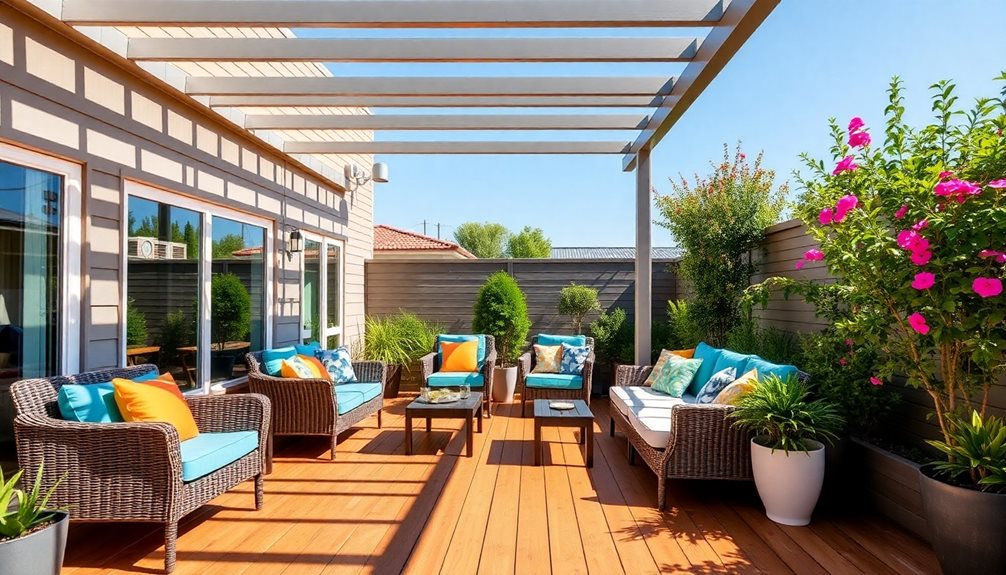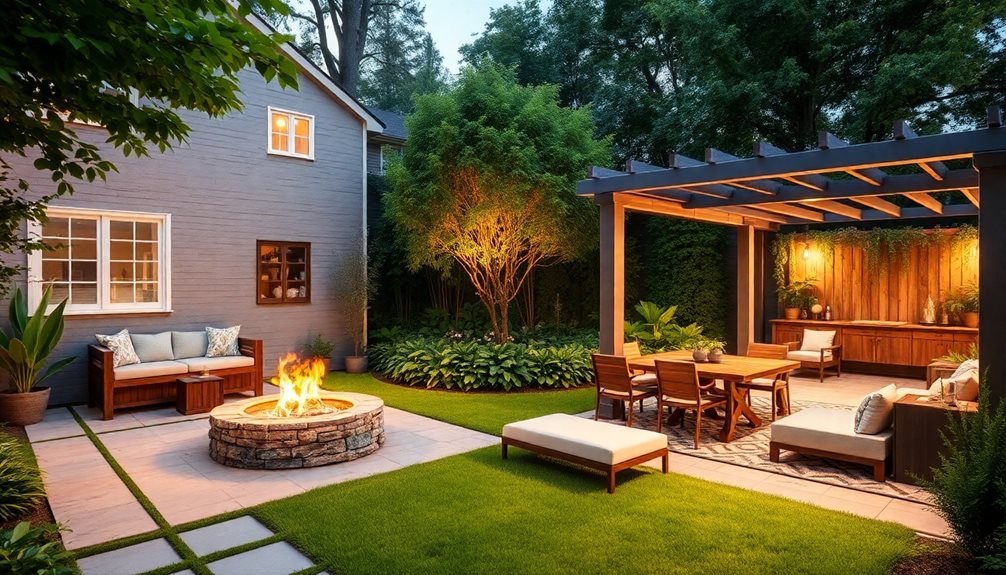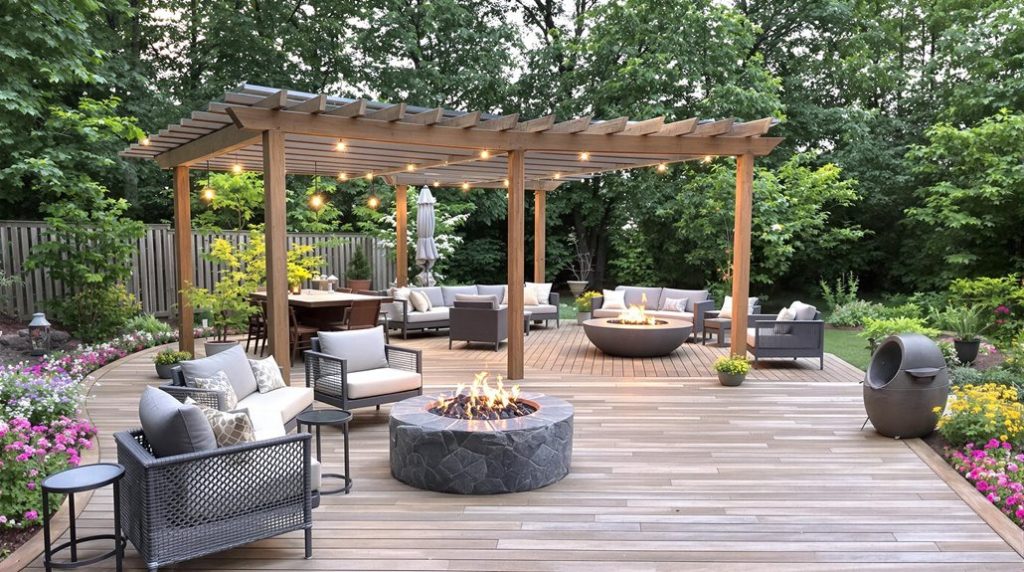Posts Tagged ‘living space’
How to Build Your Dream Outdoor Living Space
Creating a dream outdoor living space requires strategic planning across multiple dimensions, beginning with a thorough site analysis for ideal layout and traffic flow. The selection of weather-resistant materials, such as marine-grade stainless steel and solution-dyed acrylic fabrics, forms the foundation for durability. Distinct functional zones, including dining areas and conversation spaces, should be established with proper spacing and clearance. Strategic lighting, climate control features, and thoughtful plant placement enhance comfort and ambiance, while proper maintenance guarantees lasting enjoyment. Further exploration reveals specific measurements and material specifications essential for success.
Expert Highlights
- Plan your layout with careful consideration of sun exposure, traffic flow, and functional zones for dining, cooking, and relaxation areas.
- Select weather-resistant materials like marine-grade stainless steel and solution-dyed acrylic fabrics for furniture and cushions.
- Install proper lighting with LED path lights and string lights for safety and ambiance in evening hours.
- Create comfortable seating arrangements using circular or U-shaped configurations with adequate spacing between furniture pieces.
- Incorporate climate control features such as retractable awnings and outdoor heating elements for year-round enjoyment.
Planning Your Perfect Outdoor Layout

Before breaking ground on any outdoor living space, careful consideration must be given to the layout's functional requirements, spatial relationships, and environmental factors that will impact its success.
The design process begins with a thorough site analysis, documenting existing conditions such as sun exposure, prevailing winds, drainage patterns, and views. These elements inform the strategic placement of key features, including seating areas, cooking stations, and shade structures.
Traffic flow analysis guarantees seamless movement between zones while maintaining appropriate spacing for safety and comfort.
Standard measurements include 36-inch walkways, 24-inch clearance between seating, and 48-inch diameter turning spaces for accessibility compliance.
Professional installation of concrete walkways can provide durability lasting up to 30 years with proper maintenance.
Selecting Weather-Resistant Materials and Furniture

When designing an outdoor living space that will endure the elements, selecting appropriate weather-resistant materials and furnishings becomes a critical factor in ensuring long-term durability and performance.
For structural components, marine-grade stainless steel, powder-coated aluminum, and teak wood offer superior resistance to moisture, UV damage, and temperature fluctuations.
Solution-dyed acrylic fabrics, such as Sunbrella, provide fade-resistant cushions and upholstery rated for 5+ years of outdoor exposure.
High-density polyethylene (HDPE) furniture, featuring UV inhibitors and colorfast pigments, withstands extreme temperatures from -20°F to 120°F while maintaining structural integrity.
Concrete or porcelain pavers deliver slip-resistant flooring with minimal maintenance requirements.
Stamped concrete finishes offer a visually appealing and cost-effective alternative to natural stone while providing exceptional durability for outdoor spaces.
Creating Zones for Different Activities

A successful outdoor living space incorporates distinct functional zones that allow for seamless changes between different activities and social gatherings. The primary zones typically include dining areas, conversation spaces, and cooking stations, strategically separated by walkways or connecting elements.
When designing these zones, spatial relationships become critical. The cooking area should maintain proximity to indoor facilities while remaining separate from relaxation spaces.
Conversation areas benefit from circular or U-shaped seating arrangements, while dining zones require adequate clearance for chair movement and service access.
Each zone should feature appropriate lighting, shade solutions, and storage elements specific to its intended function.
Similar to concrete driveway installation, proper grading and surface preparation are essential for creating stable, long-lasting outdoor living zones.
Essential Elements for Comfort and Ambiance
To create a truly inviting outdoor living space, homeowners must carefully incorporate essential comfort and ambiance elements that transform basic outdoor areas into welcoming sanctuaries.
- Strategic lighting installations, including LED path lights, adjustable overhead fixtures, and decorative string lights, establish both safety and atmosphere while extending usability into evening hours.
- Climate control features such as retractable awnings, misting systems, and outdoor heating elements guarantee year-round comfort regardless of weather conditions.
- Thoughtful acoustic elements, incorporating water features, strategic plant placement, and sound-absorbing materials, create an immersive environment while minimizing unwanted noise from surrounding areas.
A concrete patio installation provides a durable and low-maintenance foundation that requires up to 75% less upkeep than alternative outdoor flooring materials.
Expert Final Thoughts
Building an ideal outdoor living space requires careful consideration of layout, materials, zoning, and atmospheric elements. By thoughtfully selecting weather-resistant furnishings, establishing distinct functional areas, and incorporating essential comfort features like shade and lighting, homeowners can create a versatile extension of their indoor living space. With proper planning and attention to detail, an outdoor sanctuary can serve as a valuable investment in both property value and lifestyle enhancement.

